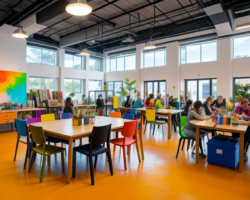Creating interactive workshops is like throwing a party where everyone is invited to dance! The key to a successful workshop lies in engaging your participants and igniting their enthusiasm. Think about it: when was the last time you sat through a presentation and felt truly involved? Probably not very often! This is why designing workshops that encourage participation is essential. By using a variety of techniques, you can transform a mundane session into a vibrant learning experience.
First, you need to understand your audience. Who are they? What do they want to learn? Tailoring your content to fit their interests is crucial. Imagine trying to sell ice to an Eskimo—it’s simply not going to work! Instead, find out what excites your participants and build your workshop around those elements. This not only keeps them engaged but also makes the learning relevant and impactful.
Next, consider incorporating technology. Tools such as polls and quizzes can turn passive listeners into active participants. It’s like adding a splash of colour to a black-and-white picture; it brings everything to life! By utilising collaborative platforms, you can foster real-time engagement and interaction, making your workshop feel dynamic and alive.
Incorporating these techniques will not only enhance the learning experience but also create a memorable event that participants will talk about long after it’s over. So, are you ready to elevate your workshops to the next level?
Understanding Your Audience
Identifying the needs and preferences of your participants is crucial when planning an interactive workshop. Imagine trying to hit a target blindfolded; it’s nearly impossible without knowing where the bullseye is! By tailoring your workshop content to their interests, you ensure a much higher level of engagement and relevance. This not only leads to a more impactful learning experience but also makes participants feel valued and understood.
To effectively grasp your audience’s needs, consider these key strategies:
- Conduct Pre-Workshop Surveys: A simple questionnaire can reveal valuable insights about your participants’ backgrounds, interests, and expectations.
- Engage in Active Listening: During initial interactions, ask open-ended questions and listen carefully to their responses. This can help you gauge their level of knowledge and interest.
- Utilise Demographic Data: If you have access to demographic information, use it to tailor your content. Knowing the age, profession, and experience level of your participants can guide your approach.
By employing these techniques, you can create a workshop that resonates with your audience, making them feel like active contributors rather than passive recipients. Remember, the more you understand your audience, the more you can transform your workshop into a memorable experience that leaves a lasting impact.
Incorporating Technology
In today’s fast-paced world, utilising technology in workshops isn’t just a bonus; it’s a necessity! Imagine walking into a workshop where every participant is engaged, their eyes glued to their screens, eagerly participating in polls and quizzes. This is the power of technology! By integrating tools like live polls, interactive quizzes, and collaborative platforms, you can create an atmosphere that encourages active participation and real-time interaction.
For instance, consider using platforms that allow for instant feedback. This not only keeps the audience on their toes but also encourages a dynamic learning environment. Participants can ask questions as they arise, making the learning process feel more like a conversation than a lecture. It’s like having a chat with friends rather than sitting through a monotonous presentation!
Furthermore, online tools such as breakout rooms and virtual whiteboards can transform a standard workshop into an immersive experience. These features promote collaboration and discussion, allowing participants to connect deeply with the content and each other. Think of it as a digital campfire where everyone gathers to share ideas and insights, fostering a sense of community even in virtual settings.
Incorporating technology not only enhances engagement but also makes learning more enjoyable. So, why not embrace these tools? They could be the key to unlocking a more interactive and memorable workshop experience!
Utilising Online Tools
In today’s digital age, has become a game-changer for creating interactive workshops. Imagine stepping into a virtual space where collaboration flows as freely as a river! Tools like breakout rooms and virtual whiteboards not only enhance communication but also foster a sense of community among participants. When you break your audience into smaller groups, it’s like giving them a chance to dive into a pool of ideas, allowing for deeper discussions and more meaningful connections.
Moreover, platforms such as Miro or Zoom provide features that encourage real-time collaboration. Participants can brainstorm together, share their screens, and visually map out their thoughts. This not only keeps everyone engaged but also transforms the learning experience into an interactive adventure. Think of it as a treasure hunt, where each participant plays a crucial role in uncovering insights and knowledge together.
Additionally, integrating tools like Padlet or Mentimeter can elevate the experience further. These platforms allow for instant feedback and participation through polls and quizzes, making it easy to gauge understanding and adapt on the fly. It’s like having a magic wand that helps you tailor the workshop to meet the needs of your audience in real-time!
Interactive Presentations
In today’s fast-paced world, have become a game-changer in how we engage our audience. Imagine sitting in a room, or even online, where the presenter isn’t just talking at you but inviting you to be a part of the conversation. This approach transforms a mundane lecture into a lively dialogue, making it not just informative but also exciting!
Utilising platforms that support interactive features allows participants to provide real-time feedback, ask questions, and even participate in polls. For instance, tools like Mentimeter or Kahoot! can be integrated into your presentation, enabling you to gauge the audience’s understanding instantly. This kind of engagement not only keeps the audience on their toes but also fosters a sense of community among participants.
Moreover, interactive presentations can include elements such as:
- Live Q&A sessions: Encouraging questions throughout the presentation makes it more dynamic.
- Instant polls: Gathering opinions on topics in real-time keeps the content relevant and tailored to the audience’s interests.
- Breakout discussions: Allowing small groups to discuss can lead to deeper insights and foster collaboration.
Ultimately, the goal is to create a two-way communication flow that not only informs but also inspires. So, the next time you’re crafting a presentation, think about how you can turn it into an interactive experience that resonates with your audience!
Gamification Strategies
Gamification strategies are all about making learning feel like a game, and who doesn’t love a bit of fun? By incorporating elements such as points, badges, and leaderboards, you can transform a traditional workshop into an exhilarating challenge. Imagine your participants not just sitting and listening, but actively competing and collaborating to earn rewards! This approach not only boosts motivation but also enhances retention of information, as participants are more likely to remember what they learned when they’ve engaged in a playful manner.
For instance, consider setting up a point system where participants earn points for completing tasks, answering questions, or participating in discussions. You could even create a leaderboard to spark a little friendly competition. To illustrate how this can work in practice, here’s a simple example:
| Activity | Points Earned |
|---|---|
| Answering a question correctly | 10 |
| Completing a group task | 20 |
| Participating in a discussion | 5 |
Incorporating gamification not only makes the learning experience more interactive but also fosters a sense of community among participants. They will cheer each other on, share strategies, and collaborate to achieve common goals. So, why not add a sprinkle of gamification to your next workshop? It could be the secret ingredient that keeps your audience engaged and eager to learn!
Facilitating Group Activities
Facilitating group activities is like being the conductor of an orchestra; your role is to harmonise different voices into a beautiful symphony of collaboration and learning. When participants engage in group tasks, they not only share ideas but also build relationships that can last beyond the workshop. Imagine a room buzzing with energy, where participants are brainstorming solutions, exchanging insights, and laughing together. This dynamic environment fosters a sense of community and belonging, which is crucial for effective learning.
Designing activities that require teamwork can enhance the overall experience. For instance, you might consider using icebreakers to get everyone comfortable or problem-solving challenges that compel participants to think critically together. These activities can range from simple discussions to complex projects, depending on the workshop’s goals. When participants collaborate, they learn from each other, and often, the best ideas emerge from these interactions.
Moreover, it’s essential to provide clear instructions and set the stage for success. Consider using a
| Activity | Objective | Roles | Expected Outcome |
|---|---|---|---|
| Brainstorming Session | Generate ideas | Facilitator, Participants | List of innovative solutions |
| Group Presentation | Share findings | Presenter, Support Team | Collaborative understanding of topics |
In summary, facilitating group activities not only enriches the learning experience but also empowers participants to become active contributors. By creating an environment where everyone feels valued and heard, you set the stage for a transformative workshop that resonates long after it ends.
Feedback and Improvement
Collecting feedback post-workshop is essential for continuous improvement. Think of it as a compass guiding you towards better experiences. By understanding what resonated with your participants and what fell flat, you can refine your future workshops to be even more engaging and effective. It’s like tuning a musical instrument; the more you listen to the notes, the better the harmony.
To gather this invaluable insight, consider using surveys and questionnaires. These tools allow participants to share their thoughts on various aspects of the workshop, from content and pacing to the effectiveness of interactive elements. You might ask questions like:
- What did you enjoy most about the workshop?
- Were the interactive activities helpful?
- What could be improved for next time?
Additionally, organising follow-up sessions can provide an excellent opportunity to reinforce learning and address any lingering questions. This ongoing engagement not only solidifies knowledge but also fosters a sense of community among participants. Just like watering a plant helps it grow, these follow-ups nurture the relationships built during the workshop.
Surveys and Questionnaires
Surveys and questionnaires are essential tools in the workshop facilitator’s toolkit. They serve as a bridge, connecting your audience’s experiences and insights back to the workshop content. By gathering feedback, you can uncover the hidden gems of participant perspectives that might otherwise go unnoticed. Imagine walking a mile in their shoes; these tools allow you to do just that!
When crafting your surveys, consider including a mix of both open-ended and closed-ended questions. Closed-ended questions can provide quantifiable data, while open-ended ones invite participants to share their thoughts in their own words. For instance, you might ask:
- What did you enjoy most about the workshop?
- What topics would you like to explore further?
This dual approach not only enriches your data but also gives participants a voice, making them feel valued and heard. Additionally, it’s vital to keep your surveys concise. A lengthy questionnaire can lead to participant fatigue, resulting in incomplete responses. Aim for clarity and brevity, ensuring that every question serves a purpose.
Finally, don’t forget to communicate how you will use their feedback. When participants see their input leading to tangible changes, they are more likely to engage in future surveys, creating a cycle of continuous improvement and connection.
Follow-Up Sessions
Follow-up sessions are an essential component in the learning journey, acting as the bridge between initial engagement and long-term retention. Think of them as the icing on the cake; they not only enhance the overall experience but also solidify the knowledge gained during the workshop. By organising these sessions, you create an opportunity for participants to revisit key concepts, clarify doubts, and deepen their understanding.
These sessions can take various forms, from informal Q&A gatherings to structured discussions. The key is to keep the atmosphere relaxed and open, encouraging participants to share their thoughts and experiences. Imagine a cosy coffee shop where ideas flow freely—this is the vibe you want to create. You might even consider incorporating interactive elements, such as:
- Live polls to gauge understanding
- Group discussions to encourage peer learning
- Interactive quizzes to reinforce concepts
Moreover, follow-up sessions foster a sense of community among participants. They feel connected, knowing they are part of a collective learning experience. By maintaining this engagement, you not only enhance knowledge retention but also build lasting relationships that can lead to future collaborations. So, why not make follow-up sessions a staple in your workshop strategy? They could be the secret ingredient that transforms your workshops from good to great!
Frequently Asked Questions
- What are the key elements of an interactive workshop?
Interactive workshops thrive on participant engagement. Key elements include understanding your audience, incorporating technology, and facilitating group activities. When you know what your participants want, you can tailor the experience to keep them hooked!
- How can technology enhance my workshop?
Utilising tools like polls, quizzes, and virtual whiteboards can significantly boost interactivity. These technologies make learning fun and dynamic, allowing participants to engage in real-time, which transforms a standard session into an exciting experience.
- Why is feedback important after a workshop?
Feedback is your golden ticket to improvement! It helps you understand what resonated with participants and what didn’t. By collecting insights through surveys or questionnaires, you can refine future workshops and ensure they meet the needs of your audience.
- What role do follow-up sessions play?
Follow-up sessions are crucial for reinforcing learning. They provide a platform for participants to ask lingering questions and deepen their understanding, creating a sense of community and continuity that enhances the overall learning experience.





